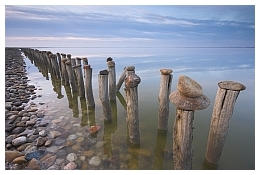News
SPIRAL "UK National Ecosystem Assessment" paper publshed
A new paper has been published based on work carried for SPIRAL, authored by Kerry Waylen and Juliette Young. This paper focuses on the first phase of the UK National Ecosystem Assessment.
Upcoming Event
No upcoming events.
Science and policy united to tackle eutrophication in Mediterranean
Together, European policy and research initiatives provide a sound basis for actions to tackle eutrophication in the Mediterranean Sea, a recent analysis concludes. The review brings together scientific understanding from over 50 years of research on eutrophication and a discussion of the policy frameworks currently in place to deal with this issue.
 High levels of certain nutrients in rivers, lakes and marine environments lead to surface blooms of phytoplankton - microscopic plants which consume oxygen and block out light from deeper layers. This leads to a scenario known as eutrophication. The nutrients that cause eutrophication, nitrogen and phosphorus, enter the marine environment in urban sewage, industrial waste and run-off from fertilisers used in agriculture. The enclosed nature of the Mediterranean and large numbers of people living on and visiting the coast contribute to the severity of the problem.
High levels of certain nutrients in rivers, lakes and marine environments lead to surface blooms of phytoplankton - microscopic plants which consume oxygen and block out light from deeper layers. This leads to a scenario known as eutrophication. The nutrients that cause eutrophication, nitrogen and phosphorus, enter the marine environment in urban sewage, industrial waste and run-off from fertilisers used in agriculture. The enclosed nature of the Mediterranean and large numbers of people living on and visiting the coast contribute to the severity of the problem.
Between 1970 and 2010, a total of 345 scientific studies investigating marine eutrophication in the Mediterranean Sea were published. Based on some of these publications, the researchers find that the most eutrophic areas in the Mediterranean are along the northern coast, with hotspots in the Gulf of Lion, the Adriatic Sea and the Northern Aegean. Satellite images of the region have been used to estimate concentrations of chlorophyll – the pigment produced by phytoplankton – across the region. These images suggest that northern and southern coastal regions are more eutrophic than eastern and western regions.
Circulation patterns, and rivers and dams control nutrient concentrations in different regions. To the south, the Aswan Dam in the River Nile limits the amount of freshwater flowing in, while sewage effluents from Egyptian cities contribute large quantities of nutrients. To the north, the Danube and other large rivers send nutrients to the Mediterranean via the Black Sea and Greek rivers empty directly into the basin.
The Iron Gate dams constructed in the Danube during the 1970s increased the amount of nitrate and decreased the amount of silicate leaving the river. A group of phytoplankton called dinoflagellates, capable of living in conditions where silicate is scarce, began to thrive. The researchers suggest the shift may have led to toxic blooms of the plants, which are dangerous to marine life and poisonous to humans, posing a serious public health problem if they reach seafood.
The study takes a close look at the current legal framework surrounding mitigation of eutrophic conditions in Europe. Eutrophication is recognised as a major problem by the European Environment Agency (EEA) and is controlled in the Mediterranean under the Barcelona Convention, Mediterranean Action Plan (MAP) and EU directives on water quality and coastal management, including the Water Framework Directive , the Marine Strategy Framework Directive, the Nitrates Directive and the Urban Waste Treatment Directive.
Monitoring of Mediterranean eutrophication is carried out under the UN MED POL1 programme, but data produced by the different countries that contribute to MED POL are of varying quality and suitable indicators for assessing water quality are still being evaluated.
The researchers suggest eutrophic hotspots need to be targeted. They also say that, overall, existing legislation, scientific information and collaborations between authorities and research facilities provide a sound basis for developing national legislation and policy to mitigate eutrophication.
Source: Karydis, M., Kitsiou, D. (2012) Eutrophication and environmental policy in the Mediterranean Sea: a review. Environmental Monitoring and Assessment. 184(8): 4931-4984.
From: Science for Environment Policy, Issue 301: A service from the European Commission




